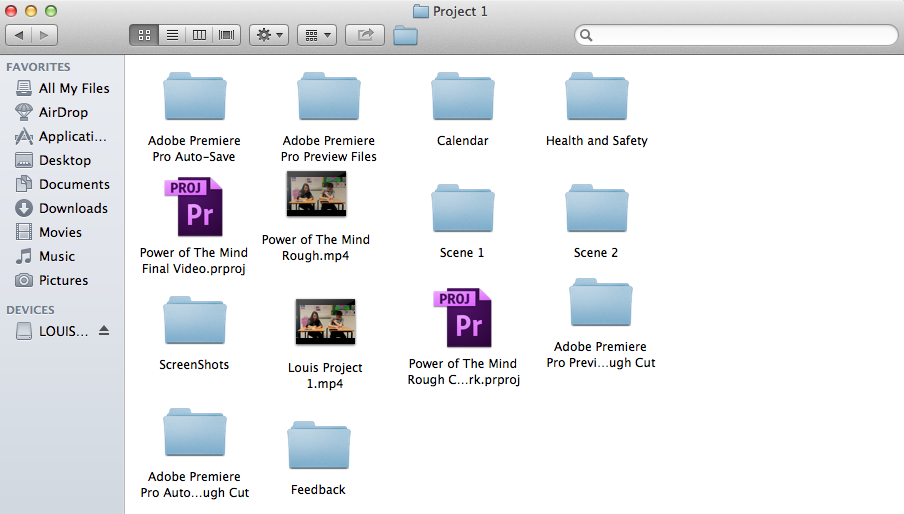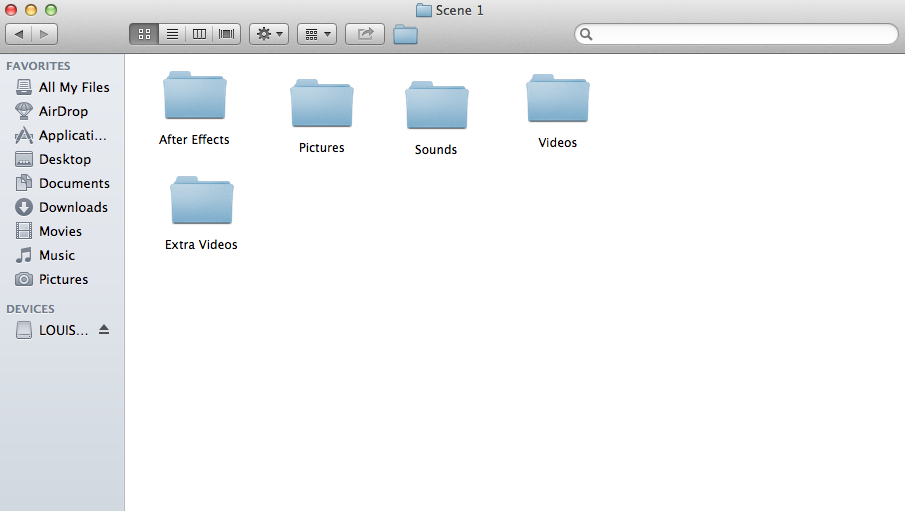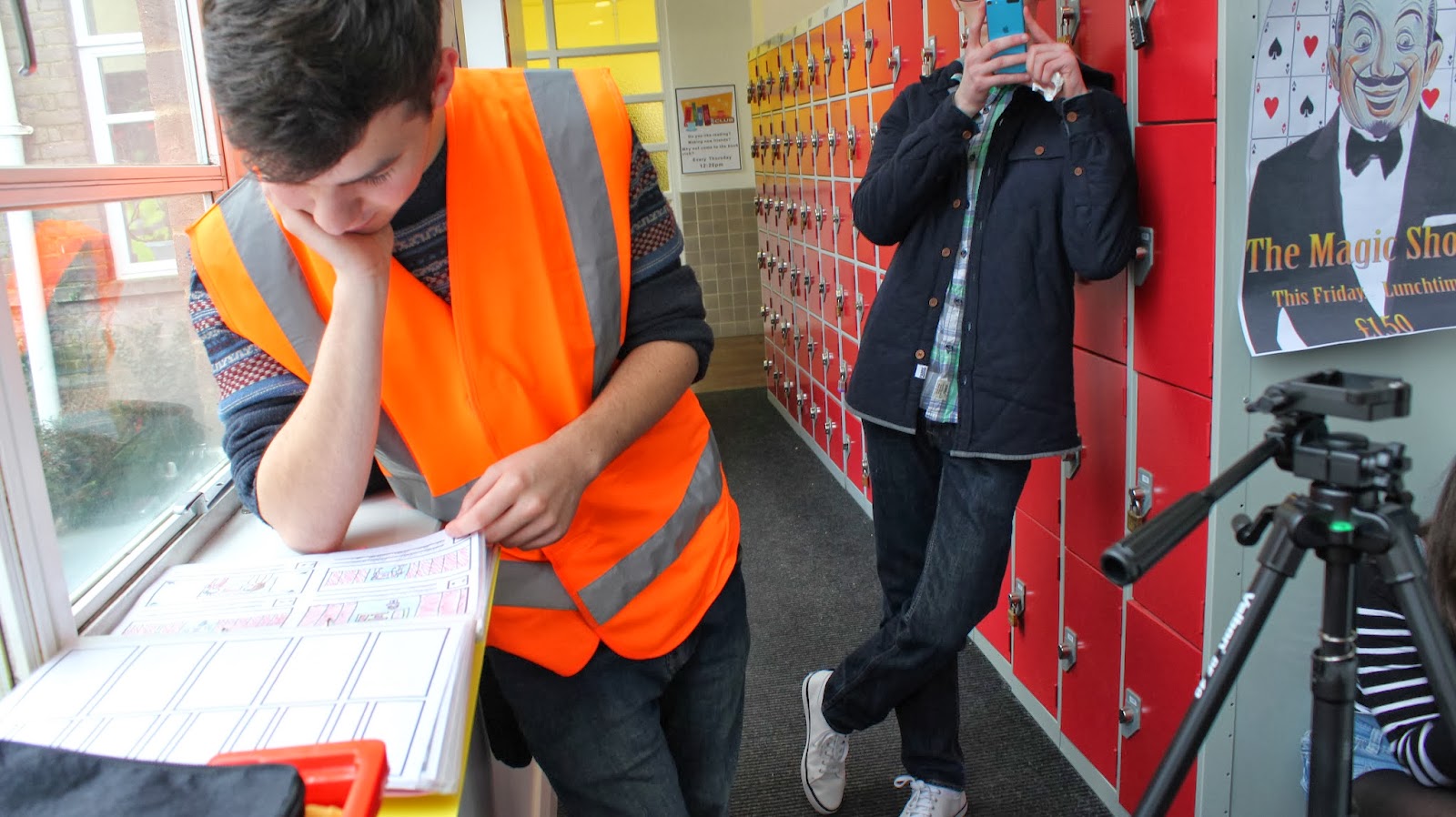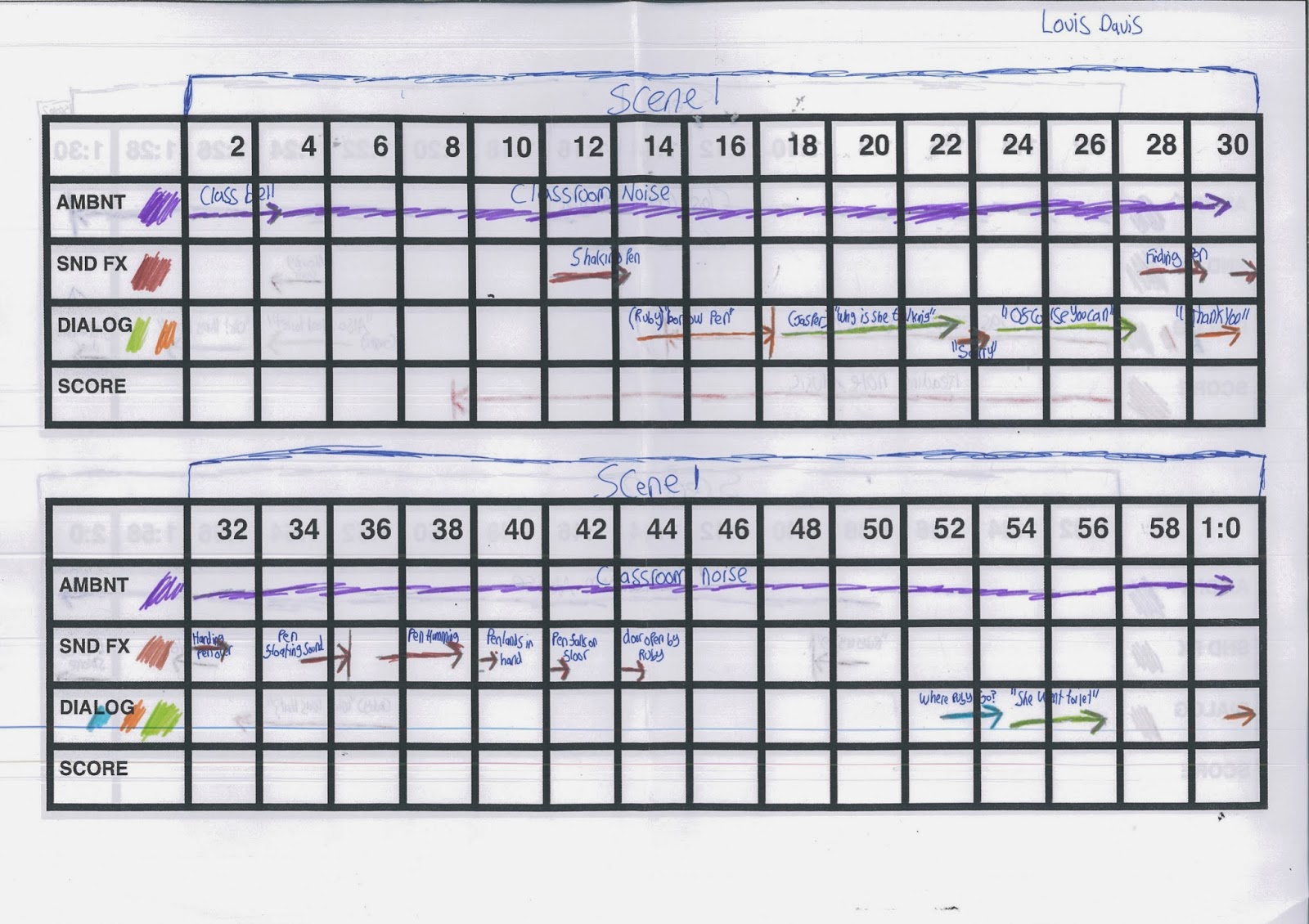Sunday, 23 February 2014
Organize Files

 I sorted all my files out into folders to make it easier to find my work, while doing my project. As you can see all my finished work ended up in the first folder project 1 so that I could locate it quickly. The folder (Scene 1) is exactly the same as folder (Scene 2) which made it easier for me to find my work because I knew which scene belongs where.
I sorted all my files out into folders to make it easier to find my work, while doing my project. As you can see all my finished work ended up in the first folder project 1 so that I could locate it quickly. The folder (Scene 1) is exactly the same as folder (Scene 2) which made it easier for me to find my work because I knew which scene belongs where.Thursday, 20 February 2014
Overview of my timeline from 23rd January 2014 - 13th February 2014
23rd January Time-line
27th January Time-line
29th January Time-line
12th February Time-line
Final Time-line 13th February
As you can tell by the pictures, over time my time-line has progressed with extra clips, sounds and special effects. I had to shorten my time table on the last day as it was a bit longer than we were suppose to have. Luckily this did not effect my overall work and I am very happy with the end result.
Health and Safety + Filming Dates
Filming 14th January 2014

Filming 15th January 2014
Filming 23rd January 2014
Filming 29th January 2014
Filming 5th February 2014
Each time we went out filming we had to fill in a A/V booking form, which had to be signed by the teacher. We also had to bring two high vis jackets, and a beware filming sign for health and safety reasons. As you can see we always wore the high vis jackets and the sign was left outside (not in harms way) to prevent people from disturbing us.
Friday, 14 February 2014
After Effects - Pen effects (masking + Glowing)
I did two effects on this pen scene. The first effect was masking over the wire and replacing it with a background image. I did this by using taking a still image of the background without the pen and placing it over the image. Once this was done I could mask out the line holding up the pen. I had to mask each individual frame to create the illusion that the pen is actually floating.
The second effect is the glowing of the pen. To do this I added the effect called CC Light rays which created this glowing effect. Once I finished messing with the CC Light ray settings to create the best amount of glow for the pen. I then went through each key frame positioning the effect for the best results. Basically this creates the illusion that the pen is glowing up but actually the CC Light rays is key framed to follow the pen.
The second effect is the glowing of the pen. To do this I added the effect called CC Light rays which created this glowing effect. Once I finished messing with the CC Light ray settings to create the best amount of glow for the pen. I then went through each key frame positioning the effect for the best results. Basically this creates the illusion that the pen is glowing up but actually the CC Light rays is key framed to follow the pen.
After Effects - Cheeky Smile
This effect was to make it seem like the character (Jasper) was thinking about the poster, hence the poster and the part of the think bubble. 1: I went into After Effects and started up new project. 2: Imported the picture of the poster and the think bubble. 3: I clicked on my cheeky file footage and created a new composition. Once all this was done I placed the think bubble on first then came the poster on top of its layer, creating this look a like thinking process. I added a few key frames and changed the opacity to make it seem like I was thinking of them. Finally I used motion tracker to move my poster and think bubble with the head.
Thursday, 13 February 2014
Wednesday, 5 February 2014
Self Appraisal
Self Appraisal - Rough Cut
Audio:
The dialogue can be heard loud and clear most of the time as we filmed most of the scenes in a quiet classroom, however sometimes you can hear the radiator in the background due to the quietness of the classroom. I was told in my feedback that the character Ruby was hard to hear sometimes. To fix this problem we have started to record the actors with a microphone speaking their lines and matching it up with the video. For the sound FXs we recorded the sound of a clock in a classroom with the microphone which we added onto are project. This was a good thing because it creates the scene/tension needed for the first opening shots, also the synchronization of both sound FX and video footage work really well together as it creates this natural feeling as if the sound was suppose to be there. I haven't yet added a sound effect for when the characters write on their pieces of papers or when the pen floats up and lands in Ruby's hand. I will do this in during the next two weeks as it will sound better and create the effect I need.
Special Effects:
I have only used 2 effects so far; the first effect was when the pen dropped and floated back up. I removed the string holding the pen up by adding a mask over it which created the hovering effect. This effect seems real as it makes the viewers believe it is actually floating. It fits suitably for the narrative as it's when Ruby and the audience members find out Jasper has a power. The second effect I have added into my project is when Jasper thinks about the poster. For this effect I made a thinking bubble appear with the image of the magic poster to tell the audience that this is what Jasper is thinking. In my opinion I could do this effect a little better so I have decided to edit it and improve the movement and appearance. In the third effect I will add some text to the screen so viewers can see what he is reading when we change camera view. I am going to add a glowing-highlighting effect onto the pen floating effect to show the audience that Jasper is using his powers.
Sequence:
I believe the acting for our project is really good because I and the other actors put 110% into are characters and made them come to life. The acting helped make sense of the narrative and kept the flow in a steady pace for the audience to connect and fully understand what they were watching. The editing for my project is smooth and is easy to follow. Unfortunately we haven't filmed every scene yet but from the responses I got from the feedback; people can see what is happening and could make sense of the narrative. This for me is a good thing because that means the video can only get better. The composition of the project is good because you can clearly see who's important and whats needed to be shown to the audience e.g. magic poster. The set dressing was also good because we made sure there was no clutter/rubbish in our clips. We created our very own posters which are carefully placed in a few scenes for viewers to spot. If we go out filming again we will film parts of scene 1 again because there a few shots missing, also there are a few clips which have mistakes in them e.g. tables magically moving. Overall the project seems to be entertaining and easily understandable to those who watch it.
Thursday, 30 January 2014
Production Meeting-Rough Cut
Production Meeting *Paula* *Alex* *Louis* *Me and alex got the same answer for the first one. It made sense but there were some missing clips.* *We only used one special effect so maybe add more in our next project.* *The audio was really effective in alex's video for example when hes thinking. I had some missing audio therefore it * *didnt make too much sense.* *2 people said that the clock ticking and the pen scribbling was really effective.* *We should add some music to our videos*
Wednesday, 29 January 2014
Tuesday, 28 January 2014
P1. Music analysis - Submarine
Purpose:
The clip shows a kid who is writing a guide for a friend at school that has previously been bullied. This is shown in a form of a montage. There are many reasons for why this music has been used in this clip. The first reason would be because it helps the narrative. It does this very well because it doesn't distract the audience when watching. The second reason would be because it creates a sonic wallpaper with the audience. The main reason for the music is because it the clip shown is a montage and with a montage you need a good steady background music.
Elements:
The tone of the music used is a mixed balanced between major and minor as it creates this neutral feeling when watching the clip. The instruments used are mostly orchestral, this means there is no vocals distracting you when watching. You can hear flutes and strings which are usually used for happy/sad things. The tempo reminds me of a brisk walking pace (andante) which is perfectly selected for a montage clip because you don't get distracted when watching. The genre of the music would be defiantly classical but with a hint of an up beat tempo to it.
Meaning:
The meaning for the music is for us, the audience to follow the main characters thoughts. Its almost like we are with him as he describes the process of school bullying and how to stop it. The music seems to fit his personality as he is slightly happy but calm at the same and the music is a slight up beat orchestral piece which creates this felling neutral balance between major and minor.
The meaning for the music is for us, the audience to follow the main characters thoughts. Its almost like we are with him as he describes the process of school bullying and how to stop it. The music seems to fit his personality as he is slightly happy but calm at the same and the music is a slight up beat orchestral piece which creates this felling neutral balance between major and minor.
P1. Use of music - legal considerations
Publishing rights are rights owned by the music publisher and include melody and lyrics. The recording rights are the recording of the song (i.e the actual sound that comes off of a CD, MP3 Record, and so on) it is a separate work of creative expression so it has its own rights.
If the Composer had died for over seventy years then the copyright would have of expired and there is no need to seek clearance for the composition, but you will need get clearance from the owner of the recording right. Incidental music is music for an advert, TV programme, radio, game video. Incidental music isn't primarily music. It can also be called soundtrack, or film score.
Creative Commons is a non profit organisation created in America. They created several copyright licenses called creative commons licenses free for those who use it (the general public). It was created to expand the range of creative works available to build upon legally and share to there friends.

Attribution: This lets people do anything to the piece of work an even distribute as long as they credited you for the original creation.
 Attribution-ShareAlike: This
license lets others remix, tweak, and build upon your work even for
commercial purposes, as long as they credit you and license their new
creations under the identical terms. This license is often compared to
“copyleft” free and open source software licenses. All new works based
on yours will carry the same license, so any derivatives will also allow
commercial use. This is the license used by Wikipedia, and is
recommended for materials that would benefit from incorporating content
from Wikipedia and similarly licensed projects.
Attribution-ShareAlike: This
license lets others remix, tweak, and build upon your work even for
commercial purposes, as long as they credit you and license their new
creations under the identical terms. This license is often compared to
“copyleft” free and open source software licenses. All new works based
on yours will carry the same license, so any derivatives will also allow
commercial use. This is the license used by Wikipedia, and is
recommended for materials that would benefit from incorporating content
from Wikipedia and similarly licensed projects.
 Attribution-NoDerivs: This
license allows for redistribution, commercial and non-commercial, as
long as it is passed along unchanged and in whole, with credit to you.
Attribution-NoDerivs: This
license allows for redistribution, commercial and non-commercial, as
long as it is passed along unchanged and in whole, with credit to you.

 Attribution-NonCommercial-ShareAlike This license lets others remix, tweak, and build upon your work
non-commercially, as long as they credit you and license their new
creations under the identical terms.
Attribution-NonCommercial-ShareAlike This license lets others remix, tweak, and build upon your work
non-commercially, as long as they credit you and license their new
creations under the identical terms.

Creative Commons is a non profit organisation created in America. They created several copyright licenses called creative commons licenses free for those who use it (the general public). It was created to expand the range of creative works available to build upon legally and share to there friends.
Attribution: This lets people do anything to the piece of work an even distribute as long as they credited you for the original creation.
Attribution-NonCommercial: This
license lets others remix, tweak, and build upon your work
non-commercially, and although their new works must also acknowledge you
and be non-commercial, they don’t have to license their derivative
works on the same terms.
Attribution-NonCommercial-NoDerivsThis license is the most restrictive of our six main licenses, only
allowing others to download your works and share them with others as
long as they credit you, but they can’t change them in any way or use
them commercially.
https://creativecommons.org
www.freesound.org
For my project I was looking for a happy up beat tune which is completely instrumental so that it doesn't disrupt the video footage. The sound was going to played underneath the letter reading scene. I got the sound from www.freesound.org and is licensed under the non-commercial license.
https://creativecommons.org
www.freesound.org
Monday, 20 January 2014
Production Meeting of The Fluffy Butterflies 20/01/14
Production Meeting
Production meeting of The Fluffy Butterflies
People in this meeting:
Paul
Alex
Louis
We have discussed that on monday we will be filming the scenes where we dont need Ruby or any of the extras as they are not free to act. We need certain shots such as the close up of the clock and some shots of Jasper. Then if we have enough time we will practice the shot of Jasper using his super powers then practice on after effects with it so we have some experience on how to do it.
On Tuesday we will do the sound effects and edit the clips that we have collected from the day before to make sure we keep on track and we dont leave the editing for the last minute.
We have decided to film on Wednesday right after college at 12.30 as everyone will be out and the room where we need to film will be free and also the actors will be available to act as its the end of the day.
On thursday we will edit all the clips we have collected from the day before as there should be plenty of shots to edit. And also we will search for some sounds if needed.
Friday we will focus on the special effects where Jasper uses his powers to pick up his pen and lands in Ruby's hand as we need to make sure we get that done. Also we will search for some more videos about special effects so we make sure we do it correctly and we do not mess up. If we do not get everything done on wednesday we will film on friday.
People in this meeting:
Paul
Alex
Louis
We have discussed that on monday we will be filming the scenes where we dont need Ruby or any of the extras as they are not free to act. We need certain shots such as the close up of the clock and some shots of Jasper. Then if we have enough time we will practice the shot of Jasper using his super powers then practice on after effects with it so we have some experience on how to do it.
On Tuesday we will do the sound effects and edit the clips that we have collected from the day before to make sure we keep on track and we dont leave the editing for the last minute.
We have decided to film on Wednesday right after college at 12.30 as everyone will be out and the room where we need to film will be free and also the actors will be available to act as its the end of the day.
On thursday we will edit all the clips we have collected from the day before as there should be plenty of shots to edit. And also we will search for some sounds if needed.
Friday we will focus on the special effects where Jasper uses his powers to pick up his pen and lands in Ruby's hand as we need to make sure we get that done. Also we will search for some more videos about special effects so we make sure we do it correctly and we do not mess up. If we do not get everything done on wednesday we will film on friday.
Tuesday, 14 January 2014
Health And Safety Talk With Gary
Before filming, make sure you always fill in a risk assessment. Climbing on things can be dangerous while filming for example benches and walls can be slippery and you could hurt yourself. If climbing please ask before doing so. Filming on stairs and down big corridors can be a risk because they are usually busy and could cause accidents. Finally when filming outside, be extra careful around wet conditions as you could fall and break the equipment or even worse, yourself. Be safe as possible when filming and take the right measure to assure this.
Monday, 13 January 2014
Friday, 10 January 2014
Subscribe to:
Comments (Atom)








































